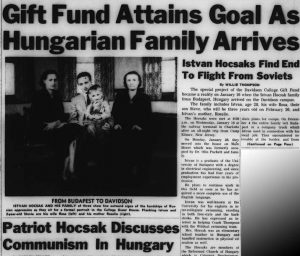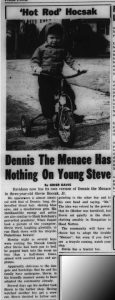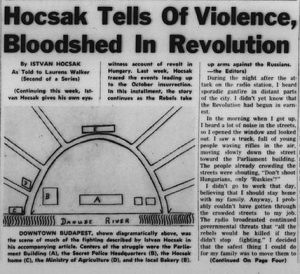Last week’s Around the D looked at student responses to conflict in Nicaragua in 1985. In 1956, Davidson students reacted to another conflict and refugee crisis by sponsoring an Hungarian family. It began with the college bringing in speakers to share their experiences of the Russian invasion and subsequent strikes within Hungary. Students followed through on their concerns by working with Church World Service to find a refugee family to sponsor. This effort was funded through the annual YMCA gift fund.
Even as the students acted, conditions in Hungary shifted making it harder for families to leave. Church World Service recommended trying to assist young men rather than families but finally was able to connect Davidson and the Hocsak family.
The Hocsaks came to Davidson on January 18, 1957 and were provided housing in a former faculty home on Main Street. The family included a young couple, their 3 year-old-son, and Mr. Hocsak’s mother. Mr, Hocsak had been an engineer in Hungary and also involved in actions against the secret police. Their escape from Budapest began on December 4, 1956. Using a truck from his company, they drove first to Vienna, crossing the border without trouble and then to Munich. They were flown to New Jersey and then sent to Davidson.
As the family settled in, students took time to visit the family. They appeared to be particularly fond of the youngest Hocsak, jokingly comparing him to a popular cartoon character of the time, Dennis the Menace. He earned the comparison in part by his antics on his tricycle.
Over the next few weeks, the Davidsonian published a 3 part series narrated by Istvan Hocsak about their experiences and political conditions in Hungary. In the first article, he described how he became involved in the freedom movement,
“In early October the first step toward revolution was taken. The students at the University in Szeged broke away from the old Communist youth organization, ‘Disz,’ and formed a new group. This group drew up a proclamation demanding a free press, a release from compulsory study of Russian, and a promise that Hungarian uranium be left in Hungary and not shipped to Russia.
I heard about this movement on October 20, and spent the next couple of days trying to find out more about the proposals. After the twentieth everybody was talking about revolution. In my office we were all exhilarated by the thought that perhaps the oppression was nearly over.
On the 22nd a great mass meeting was held at my university, the Polytechnical University of Budapest. Nearly all of the 11,000 students in the school were there. . . . I was at work and could not be at the meeting, but a colleague of mine brought me a mimeographed copy of the Proclamation. We typed as many as we could and distributed them in the building. Everybody was excited. Enthusiasm was sweeping through the people like a fever.”
He went on to recount that at 6pm that same day, a crowd gathered in front of the Parliament building. They waited until 8:30pm when Insre Nagy came out. His speech disappointed the crowd. “I decided to go home and see if my family was safe. During the time that I was home, between 9 and 10 o’clock, a group of students decided to broadcast the proclamation. When the crown reached the broadcasting station, they were met by the Secret Police. They told the crowd to go away, but the crowd moved on toward the building. The police fired, and the Revolution had begun.”
By the following fall, the Davidsonian was reporting that the Hocsaks were well settled – now on North Thompson Street. Istvan, now being known as Steve, was employed by a Charlotte firm as a draftmen and Rosie Hocsak was working for the Ivey’s department store company. Their language skills had improved through tutoring by local teaching legend Maude Vinson.
In 1962, the Charlotte News did another follow-up article on the family. By then they were living in Charlotte with Steve having recently changed jobs. According to the News, “Today the Hocsaks are Charlotteans with Hungarian accents just five years out of Budapest. They live in a $14,000 home on Birchcrest Drive, they own a second-hand Buick, they watch television, they have an air conditioner, they belong to the Third Presbyterian Church and the PTA at Windsor Park School, they pay taxes, they have a mortgage, they both work– and they have a swimming pool.”
A swimming pool might seem an oddity in this story but the Hocsaks met at a pool. Steve was a competitive swimmer in college. The article doesn’t mention if they ever go back to visit Davidson but does provide evidence that the YMCA gift fund and student support made a significant difference in their lives.








Speak Your Mind